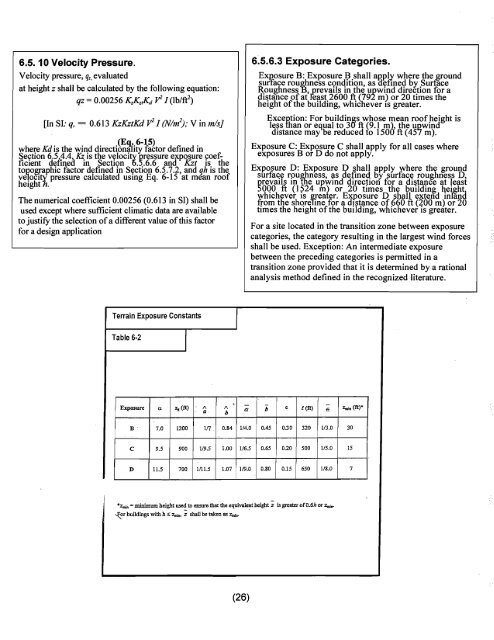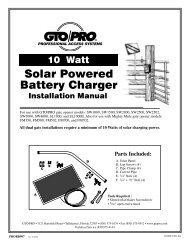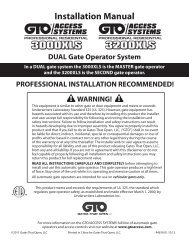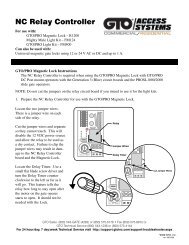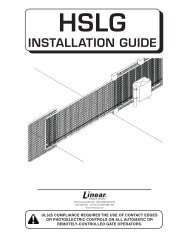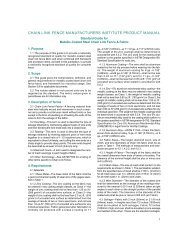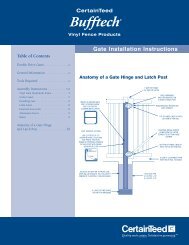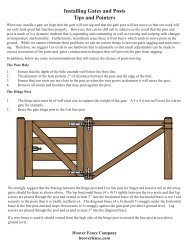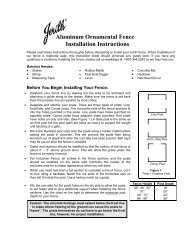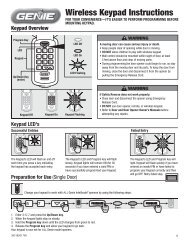Chain Link Fence Wind Load Guide for the ... - Hoover Fence
Chain Link Fence Wind Load Guide for the ... - Hoover Fence
Chain Link Fence Wind Load Guide for the ... - Hoover Fence
Create successful ePaper yourself
Turn your PDF publications into a flip-book with our unique Google optimized e-Paper software.
6.5. 10 Velocity Pressure.Velocity pressure, qz, evaluatedat height z shall be calculated by <strong>the</strong> following equation:qz = 0.00256 KzKz1K d V 2 I (lb/ff)[In SI: q, = 0.613 KzKztKd V 2 I (N/m 2 ); V in m/s}w h ere vd· h . dd· .( Eq l··6-l5) dfi d·1\.1 IS t e wm Irectiona Ity lactor e me mSection 6.5.4.4"Kz is <strong>the</strong> velocity pressure exposure coefficientdefineo in Section 0.5.6.6 and Kzt is <strong>the</strong>topographic factor defined in Section 6.5.7.2, and qh is <strong>the</strong>velocItY pressure calculated using Eq. 6-15 at mean roofhelght7z.The numerical coefficient 0.00256 (0.613 in SI) shall beused except where sufficient climatic data are availableto justify <strong>the</strong> selection ofa different value ofthis factor<strong>for</strong> a design application6.5.6.3 Exposure Categories.Exp-osure B: Exposure B shall ap'ply where <strong>the</strong> ~roundsurface roughness condition, as Clefined by SurfaceRoughness B, prevails in <strong>the</strong> upwind direction <strong>for</strong> adistance ofat least 2600 ft (792 m) or 20 times <strong>the</strong>height of<strong>the</strong> building, whicbever IS greater.Excep.tion: For buildings whose mean roof height isle~s than or equal to 30 ft (9.1 m), <strong>the</strong> uQwinddistance may be reduced to 1500 ft (457 m).Exposure C: Exposure C shall apply <strong>for</strong> all cases whereexposures B or D do not apply.Exposure D: Exposure D shall apply where <strong>the</strong> groundsurface roughness, as defined by surface roughness D,prevails in The upwind direction <strong>for</strong> a distance at least5000 ft (1524 m) or 20 times <strong>the</strong> building heightwhichever is greater. Exposure D shall extend inlandfrom <strong>the</strong> shoreline <strong>for</strong> a distance of 660 ft (200 m) or 20times <strong>the</strong> height of <strong>the</strong> building, whichever is greater.For a site located in <strong>the</strong> transition zone between exposurecategories, <strong>the</strong> category resulting in <strong>the</strong> largest wind <strong>for</strong>cesshall be used. Exception: An intermediate exposurebetween <strong>the</strong> preceding categories is permitted in atransition zone provided that it is determined by a rationalanalysis method defined in <strong>the</strong> recognized literature.Terrain Exposure ConstantsTable 6-2IExposureIXZ. (ft)/\a·/\babcL (it)EZ"d. (ft)·B-7.012000.841/4.0OA50.303201/3.030c9.5900 1/9.5 1.00 1/6.5 0.65 0.20 500 1/5.015DlJ.5700 1/11.5 1.07 119.0 0.80 0.15 650 1/8.07.z,.;" = minimum height use~11> ensure that <strong>the</strong> equival«mt height; is greater of0.6h or z"w,.--zor buildings with h 5 z,.;", z shall be taken as z,.;".(26)


